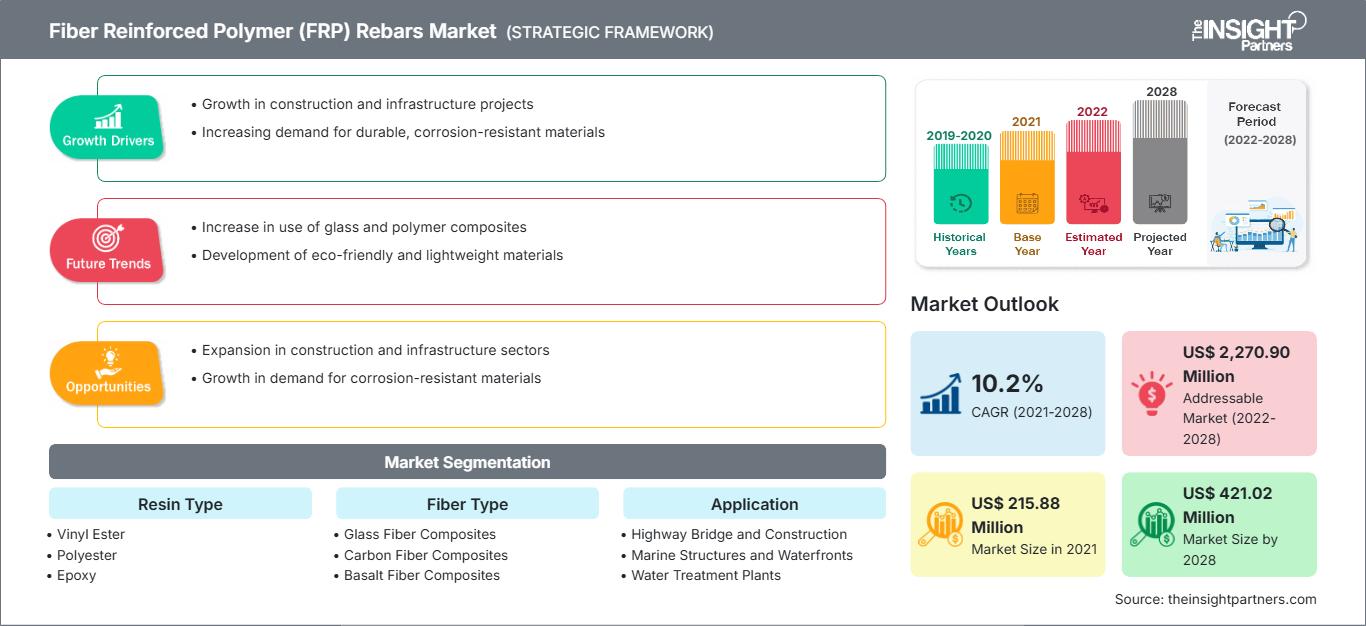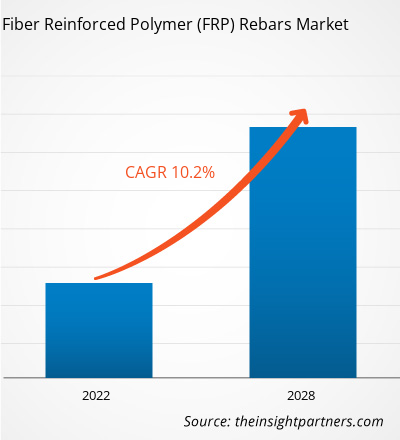The fiber reinforced polymer (FRP) rebars market is expected to grow from US$ 215.88 million in 2021 to US$ 421.02 million by 2028; it is estimated to grow at a CAGR of 10.2% from 2022 to 2028.
As concrete is strong in compression and weak in tension, it is typically strengthened to create a building material that is strong in tension and compression. This reinforcement conventionally consists of steel due to its low cost, high strength, and high elasticity. However, steel corrosion could cost governments and asset owners billions of dollars in maintenance costs to replace or repair aging infrastructure. There are few alternatives for concrete reinforcing materials that can be used to prevent corrosion. For example, some manufacturers offer stainless steel rebars; however, fiber reinforced polymer rebar can serve as a non-corrosive alternative to conventional steel rebar for concrete reinforcement. These FRP rebars are made with the combination of polymer matrix with glass, carbon, or basalt fibers. These materials don't rust, are much lighter than steel, do not transmit heat, and are nearly four times stronger in tension. The anti-corrosion ability makes fiber reinforced polymer the best alternative for various construction applications such as retaining walls, piers, jetties, quays, caissons, decks, bulkheads, pilings, canals, offshore platforms, swimming pools, and aquariums.
Furthermore, in electromagnetically sensitive applications, glass and polymer nonconductive properties of FRP rebars won't transmit current, attract lightning strikes or interfere with the operation of nearby electrical devices. That makes fiber reinforced polymer a safer alternative to steel in aluminum and copper smelting plants, airport towers, nuclear power plants, specialized military structures, electrical and phone transmission towers, manholes containing electrical or phone equipment, and hospitals with magnetic resonance imaging (MRI) equipment.
Customize This Report To Suit Your Requirement
You will get customization on any report - free of charge - including parts of this report, or country-level analysis, Excel Data pack, as well as avail great offers and discounts for start-ups & universities
Fiber Reinforced Polymer (FRP) Rebars Market: Strategic Insights

-
Get Top Key Market Trends of this report.This FREE sample will include data analysis, ranging from market trends to estimates and forecasts.
Market Insights
Growing Construction Activities Boost Fiber Reinforced Polymer (FRP) Rebars Market Growth
The construction industry is one of the major contributors to the economic development across the globe. It is flourishing rapidly due to increasing government support for infrastructure development across the globe. For instance, India planned to spend US$ 1.4 trillion on infrastructure through the National Infrastructure Pipeline from 2019 to 2023. In this pipeline, the government has included infrastructures such as power, bridges, dams, roads, and urban infrastructure development. Due to their advantageous material properties such as high strength, tolerance for frost and de-icing salts, and short installation times with minimum traffic interference, fiber reinforced polymers have matured to become valuable substitute building materials for bridge structures. Such initiatives of the governments of different countries are expected to boost the growth of the fiber reinforced polymer (FRP) rebars market.
Resin Type Insights
Based on the resin type, the global fiber reinforced polymer (FRP) rebars market is segmented into vinyl ester, polyester, epoxy, and others. In 2021, the vinyl ester segment held the largest market share. Vinyl ester resins have high strength; high resistance to corrosion, fuels, chemicals, or vapors; and offer mechanical toughness. They have great durability, heat resistance, and high tensile elongation strength. This resin can be impregnated with short glass fiber or carbon fiber to produce FRP rebars. The majority of the fiber reinforced polymer rebar manufacturers use vinyl ester resin. The cost-effectiveness of vinyl ester has boosted the growth of the segment.
Owens Corning; KODIAC Fiberglass Rebar; MARSHALL COMPOSITE TECHNOLOGIES, LLC; TUF-BAR; Armastek USA; Pultron Composites; FiRep Inc.;PULTRALL, Inc.; Schock Bauteile GmbH; and Dextra Group are among the major players operating in the globalfiber reinforced polymer(FRP) rebars market. The leading players adopt strategies such as mergers and acquisitions and product launches to expand their geographic presence and clientele. For instance, Pultron Composites established a partnership with Saudi Aramco, Saudi Arabia's leading oil company, to increase its glass fiber reinforced polymer (GFRP) rebar production facilities in the country.
Fiber Reinforced Polymer FRP Rebars
Fiber Reinforced Polymer (FRP) Rebars Market Regional InsightsThe regional trends and factors influencing the Fiber Reinforced Polymer (FRP) Rebars Market throughout the forecast period have been thoroughly explained by the analysts at The Insight Partners. This section also discusses Fiber Reinforced Polymer (FRP) Rebars Market segments and geography across North America, Europe, Asia Pacific, Middle East and Africa, and South and Central America.
Fiber Reinforced Polymer (FRP) Rebars Market Report Scope
| Report Attribute | Details |
|---|---|
| Market size in 2021 | US$ 215.88 Million |
| Market Size by 2028 | US$ 421.02 Million |
| Global CAGR (2021 - 2028) | 10.2% |
| Historical Data | 2019-2020 |
| Forecast period | 2022-2028 |
| Segments Covered |
By Resin Type
|
| Regions and Countries Covered |
North America
|
| Market leaders and key company profiles |
|
Fiber Reinforced Polymer (FRP) Rebars Market Players Density: Understanding Its Impact on Business Dynamics
The Fiber Reinforced Polymer (FRP) Rebars Market is growing rapidly, driven by increasing end-user demand due to factors such as evolving consumer preferences, technological advancements, and greater awareness of the product's benefits. As demand rises, businesses are expanding their offerings, innovating to meet consumer needs, and capitalizing on emerging trends, which further fuels market growth.

- Get the Fiber Reinforced Polymer (FRP) Rebars Market top key players overview
Report Spotlights
- Progressive trends in the fiber reinforced polymer (FRP) rebars industry to help players develop effective long-term strategies
- Business growth strategies adopted by companies to secure growth in developed and developing markets
- Quantitative analysis of the global fiber reinforced polymer (FRP) rebars market from 2022 to 2028
- Estimation of the demand for fiber reinforced polymer (FRP) rebars
- Porter's analysis to illustrate the efficacy of buyers and suppliers operating in the industry to predict the market growth
- Recent developments to understand the competitive market scenario and the demand for fiber reinforced polymer (FRP) rebars
- Market trends and outlook, and factors driving and restraining the global fiber reinforced polymer (FRP) rebars market growth
- Understanding the strategies that underpin commercial interest with regard to the global fiber reinforced polymer (FRP) rebars market growth, aiding in the decision-making process
- Global fiber reinforced polymer (FRP) rebars market size at various nodes of market
- Detailed overview and segmentation of the global fiber reinforced polymer (FRP) rebars market, and its industry dynamics
- Global fiber reinforced polymer (FRP) rebars market size in various regions with promising growth opportunities
The " Fiber Reinforced Polymer (FRP) Rebars Market Analysis to 2028" is a specialized and in-depth study of the chemicals and materials industry, focusing on the fiber reinforced polymer (FRP) rebars market trend analysis. The report aims to provide an overview of the market with detailed segmentation. The fiber reinforced polymer (FRP) rebars market is segmented into resin type, fiber type, application, and geography. Based on resin type, the market is segmented into vinyl ester, polyester, epoxy, and others. Based on fiber type, the market is segmented into glass fiber composites, carbon fiber composites, and basalt fiber composites. Based on application, the market is segmented into highway bridge and construction, marine structures and waterfronts, water treatment plants, and others. Based on geography, the market is segmented into five main regions—North America, Europe, Asia Pacific, the Middle East & Africa, and South & Central America. In 2021, North America dominated the fiber reinforced polymer (FRP) rebars market. However, Asia Pacific is expected to register the highest CAGR in the market during the forecast period.
Frequently Asked Questions
In 2021, which region held the largest share of the global fiber reinforced polymer (FRP) rebars market?
Can you list some of the major players operating in the global fiber reinforced polymer (FRP) rebars market?
In 2021, which resin type segment accounted for the largest share in the fiber reinforced polymer (FRP) rebars market?
In 2021, which application segment accounted for the largest share in the fiber reinforced polymer (FRP) rebars market?
What is the key driver for the growth of the global fiber reinforced polymer (FRP) rebars market?
Which fiber type segment is expected to account for the fastest growth in the global fiber reinforced polymer (FRP) rebars market?
- Historical Analysis (2 Years), Base Year, Forecast (7 Years) with CAGR
- PEST and SWOT Analysis
- Market Size Value / Volume - Global, Regional, Country
- Industry and Competitive Landscape
- Excel Dataset
Recent Reports
Testimonials
Reason to Buy
- Informed Decision-Making
- Understanding Market Dynamics
- Competitive Analysis
- Identifying Emerging Markets
- Customer Insights
- Market Forecasts
- Risk Mitigation
- Boosting Operational Efficiency
- Strategic Planning
- Investment Justification
- Tracking Industry Innovations
- Aligning with Regulatory Trends





















 Get Free Sample For
Get Free Sample For